Look up to see July's Super Buck Moon on Sunday and Monday nights

Eyes to the sky on Sunday and Monday nights to see July's Super Buck Moon!
Check your local forecast for clear weather because the first supermoon of 2023 will soon rise and shine in our night sky.
The next Full Moon occurs at precisely 11:39 UTC on Monday, July 3 (7:39 a.m. EDT/4:39 a.m. PDT). However, with the very subtle way that the Moon transitions from 'Gibbous' to 'Full' and back to 'Gibbous', to the casual observer, it can appear full for up to three days!
At the very least, we will see the Full Moon on Sunday night through Monday morning and again on Monday night through Tuesday morning.
What is a 'Buck' Moon?
According to NASA, there are many names for this Full Moon. Nearly a century ago, the Maine Farmer's Almanac began using the term 'Buck Moon', attributing it to the Algonquin peoples of the northeastern United States.
"Early summer is normally when the new antlers of buck deer push out of their foreheads in coatings of velvety fur," they wrote. "They also called this the Thunder Moon because of early Summer's frequent thunderstorms."
Lightning safety tips: "When thunder roars, go indoors!"

This graphic collects all the relevant data about each of the 13 Full Moons of 2023, including their popular names, whether they are a 'super' or 'micro' Moon, a 'perigee' or 'apogee' Full Moon, and if they are remarkable in some other way (Harvest Moon, lunar eclipse, etc.). Credit: Scott Sutherland/NASA's Scientific Visualization Studio/Fred Espenak
It's known as the Hay Moon in parts of Europe, as this is traditionally the time of year for haymaking, and also the Mead Moon.
Hindus, Buddhists, and Jains call it the Guru Full Moon (or Guru Purnima) — a time to honour spiritual or academic gurus.
OK, so what's a 'super' moon?
If you carefully observe the Moon, night by night, you will notice that along with its changing phases, it also gets bigger and smaller in our sky over the course of a month.
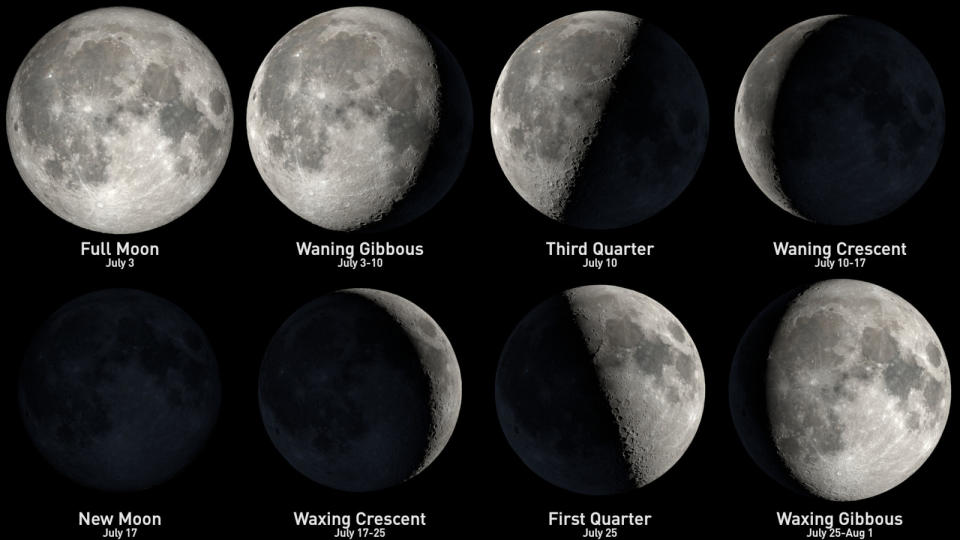
The phases of the Moon for July 2023. The size of the Moon changes from frame to frame, as it reaches perigee on July 4 and swings through apogee on July 20. Note that while Full Moon, Last Quarter, New Moon, and First Quarter each occur on one specific day. Conversely, the Waning Gibbous, Waning Crescent, Waxing Crescent and Waxing Gibbous phases each occur over a range of dates. Credit: Scott Sutherland/NASA's Scientific Visualization Studio
This apparent difference in size is due to the shape the Moon traces out as it orbits around Earth. Rather than a perfect circle, it instead follows an elliptical path around our planet. So, that means sometimes the Moon is closer to Earth, and the nearest point it reaches in an orbit is known as perigee. At other times it is farther away, and its farthest point in an orbit is known as apogee.
Also, due to this elliptical orbit, throughout the year, each Full Moon we see occurs at a slightly different distance from Earth. Thus, some Full Moons appear smaller and dimmer, while others look bigger and brighter in the sky.
The biggest and brightest Full Moons are called Supermoons.
The term was first used back in 1979 by astrologer Richard Nolle, who defined it as "a new or full moon which occurs with the Moon at or near (within 90% of) its closest approach to Earth in a given orbit (perigee)."
Depending on the year, there can be between two and five supermoons. In 2023, there are four. July 3, we see the first, followed by the Full Moons on August 1, August 31, and September 29.
Without some way of direct comparison, it's challenging to notice precisely how big any particular Full Moon is compared to normal (and the Moon Illusion doesn't help us... read on for more about that phenomenon). Much more often, we notice how much brighter the Moon is.
According to retired NASA scientist Fred Espenak, this supermoon is roughly 25 per cent brighter than February's apogee Full Moon (the farthest, smallest and dimmest Full Moon of this year), and nearly 13 per cent brighter than an average Full Moon, as we saw back in April or May.
READ MORE: Why is the supermoon so compelling to us?
And what about a 'Gibbous' Moon?
Gibbous isn't exactly one of the most common words we use. In fact, it's unlikely you'll hear it outside of a discussion about the Moon's phases.
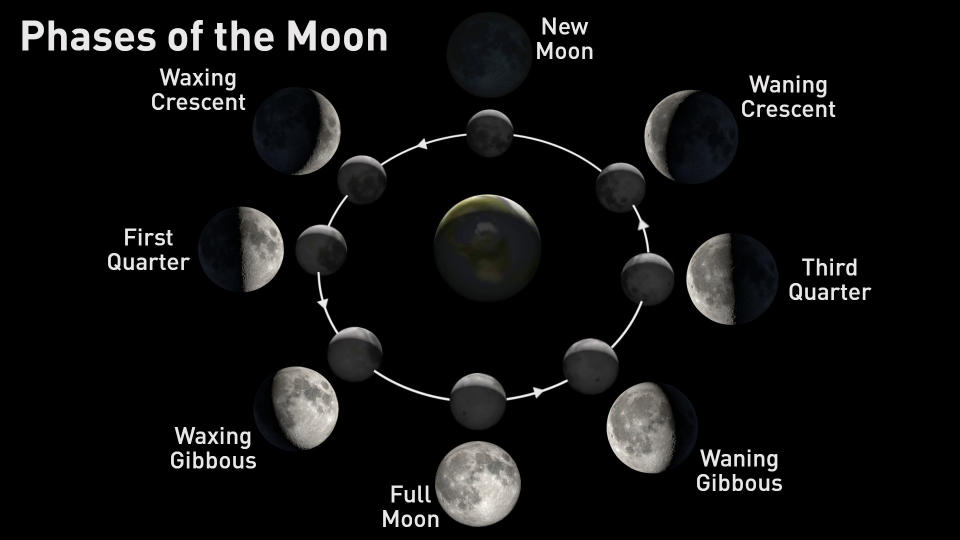
The eight phases of the Moon during each orbit. Credit: Scott Sutherland/NASA's Scientific Visualization Studio
Basically, a 'Gibbous' Moon is anytime more than half of the Moon is illuminated (when viewed from our perspective here on Earth), except when the Moon is completely illuminated during the Full Moon.
So, as shown in the diagram above, once the Moon passes through its First Quarter, it is a Waxing Gibbous Moon until it reaches the Full Moon phase. It then becomes a Waning Gibbous Moon until it reaches its Third Quarter.
It's not alone
The Super Buck Moon will not be completely alone on Sunday and Monday nights.
Just as it rises in the east, turn around and look to the west. There, you will see Venus shining brightly above the horizon. Depending on how dark your sky is, if you look closely, you may also spot the planet Mars nearby.
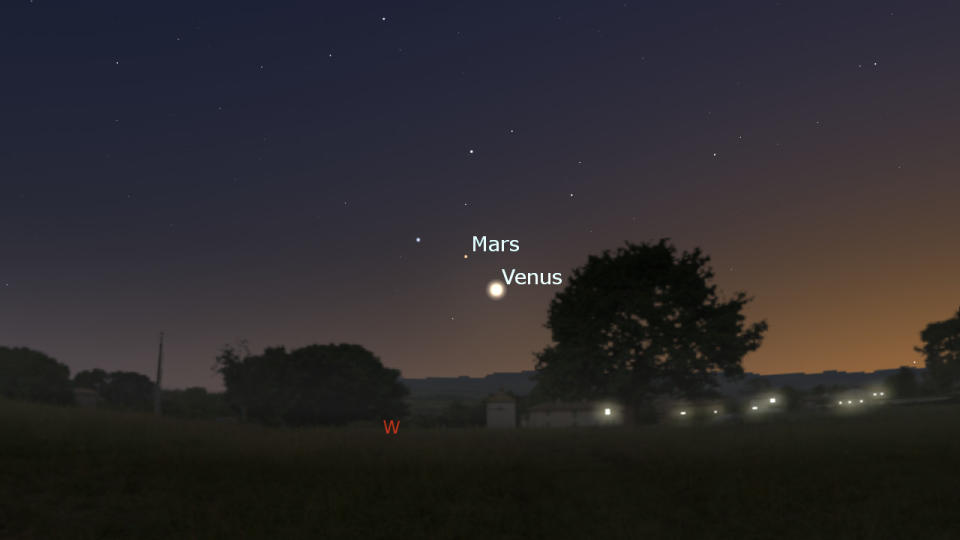
Venus and Mars shine bright in the western sky just after sunset on July 2 and July 3, 2023. Credit: Stellarium
As the Moon continues its path across the night sky, it will be followed by two other bright planets — Saturn and Jupiter.
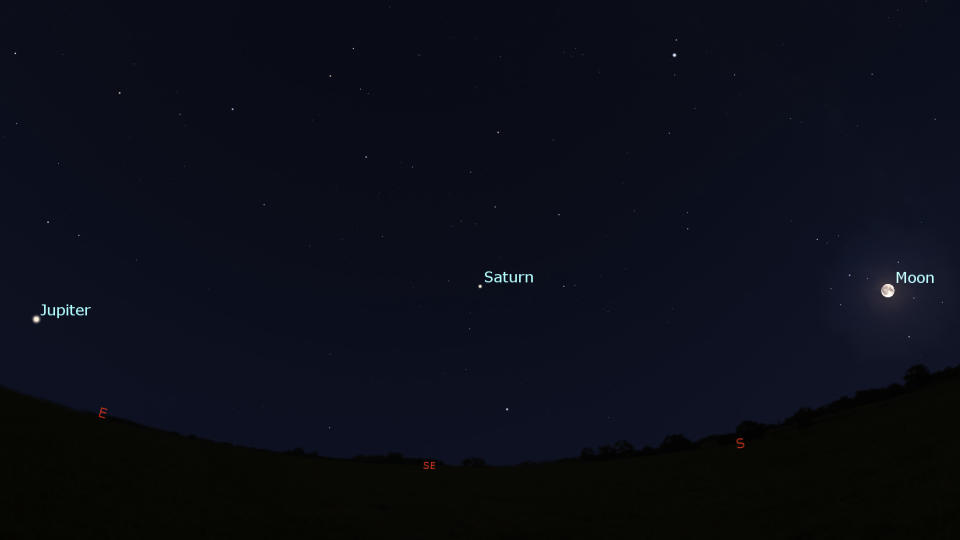
A view of the night sky at 3 a.m. local time on July 3, 2023, shows the arrangement of Saturn and Jupiter along with the Super Buck Moon. Credit: Stellarium
Watch for Saturn to rise around midnight, local time, with Jupiter rising just after 2 a.m., local time.
DON'T MISS: The best products for stargazing this summer
The Mysterious Moon Illusion
Seeing the Full Moon at any time of night is a spectacular sight. However, go out just after moonrise or before moonset to see the Moon at its biggest!
This is not something the Moon itself is doing, though. In fact, when the Moon is just above the horizon, it's actually around 6,300 kilometres farther away from you than when it is directly overhead.
Instead, the apparent size of the Moon when it is close to the horizon is due to a little trick of our mind known as The Moon Illusion.
As our eyes take in the world around us, our brain knows from experience that objects close to us tend to appear larger and in focus. In contrast, distant objects tend to be tiny and blurry. From this, it also knows that for a distant object to appear in focus, it must be enormous.
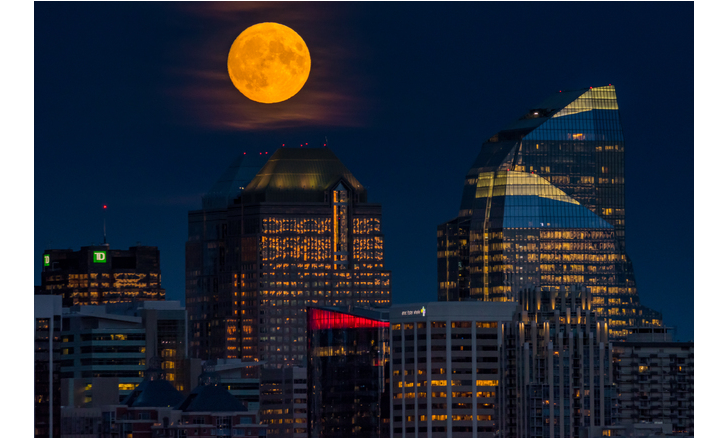
This close-up of the Harvest Moon was snapped in Calgary, AB, on September 13, 2019. Credit: Siv Heang
So, when we see a bright Full Moon hanging crisp and clear in the sky above the horizon, it is contrasted by all of the objects on the ground, which appear smaller and blurrier the closer they are to the horizon. This combination confuses the brain. So, to compensate, the brain interprets the Full Moon as much bigger than it truly is. To be clear, the Moon is certainly much larger than any of the objects on the horizon (it's 3,474 km across), but this 'illusion' gives us the impression that the Moon looks enormous!
Look up into the sky closer to the middle of the night, and the Moon will be high above our heads. Usually, it will be the only thing we see, other than the stars and maybe a few planets. At that time, the brain is focused only on the Moon, and without the other objects in the field of view to complicate matters, it is free to just 'see' its actual size.

This zoomed-in image of the Full Moon was captured from Salisbury, NB, on February 9, 2020, and uploaded into the Weather Network's UGC gallery. Credit: Darlene MacLeod/Smith
We have a few tricks of our own that can cancel out the Moon illusion, though.
For the first one, we don't need technology. Just go outside after sunset and find the Moon near the horizon. Stretch your arm towards it, and cover the Moon with your thumb or even your pinky finger. Note how big the Moon looks compared to the digit in question, and keep that in mind. Maybe even take a picture of it if you want. Later in the night, check out the Moon again when it is high in the sky. It may appear smaller than when you saw it earlier, but repeat the step to cover it with your thumb or finger. Compare it with what you saw before, and you'll find that the Moon is precisely the same size at both times.
There is a way technology can help us, though. When the Moon is low on the horizon, take out your cell phone, turn your camera on, and point it at the Moon. Note: it is possible for the Moon illusion to still work on us when looking at a picture or video. This is because the brain will make the same judgments of distance, blurriness, and size as it did when looking at a 'live' scene. Still, directly comparing what we see in the sky at that time to what is shown on our small cell phone screen can help put things into better perspective. Plus, you can also take a few pictures to upload into the Weather Network UGC Gallery while you're at it!
(Thumbnail image courtesy of Bruce Shapka, who uploaded his picture of the July 2022 Super Buck Moon into the Weather Network UGC gallery)

